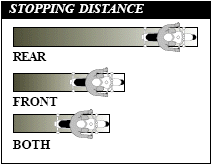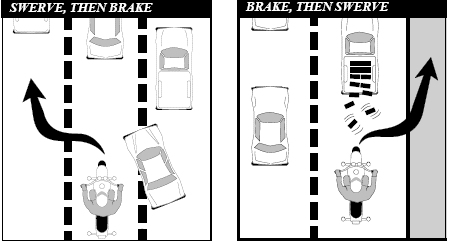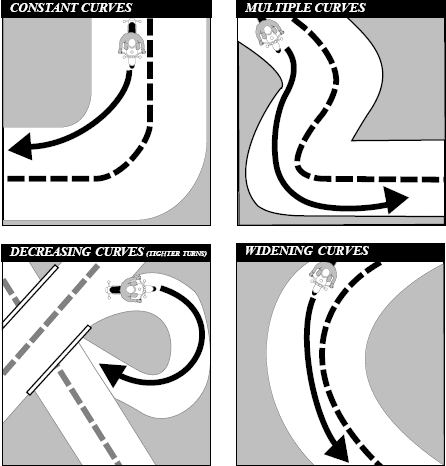Florida Motorcycle Handbook: Crash Avoidance
5. Ride within your Abilities
- 5.1. Basic Vehicle Control
- 5.6. Keeping your Distance
- 5.7. Lane Positions
- 5.8. Following Another Vehicle
- 5.9. Being Followed
- 5.10. Passing and Being Passed
- 5.11. Lane Sharing
- 5.12. Merging Cars
- 5.13. Cars Alongside
- 5.14. S.E.E.
- 5.15. Increasing Rider Visibility
- 5.16. Crash Avoidance
- 5.17. Handling Dangerous Surfaces
- 5.18. Mechanical Problems
- 5.19. Unavoidable Hazards
- 5.20. Getting Off the Road
- 5.21. Carrying Passengers and Cargo
- 5.22. Group Riding
- 5.23. Riding While Impaired
No matter how careful you are, there will be times when you find yourself in a tight spot. Your chances of getting out safely depend on your ability to react quickly and properly. Often, a crash occurs because a rider is not prepared or skilled in crash-avoidance maneuvers.
Know when and how to stop or swerve, two skills critical to avoiding a crash. It is not always desirable or possible to stop quickly to avoid an obstacle. Riders must also be able to swerve around an obstacle. Determining the skill necessary for the situation is important as well.
Studies show that most crash-involved riders:
- Underbrake the front tire and overbrake the rear.
- Did not separate braking from swerving or did not choose swerving when it was appropriate.
The following information offers some good advice.
5.16.1 - QUICK STOPS

To stop quickly, apply both brakes at the same time. Don't be shy about using the front brake, but don't "grab" it, either. Squeeze the brake lever firmly and progressively. If the front wheel locks, release the front brake immediately, then reapply it firmly. At the same time, press down on the rear brake. If you accidentally lock the rear brake on a good traction surface, keep it locked until you have completely stopped. Even with a locked rear wheel, you can control the motorcycle on a straightaway if it is upright and going in a straight line.
Always use both brakes at the same time to stop. The front brake can provide 70% or more of the potential stopping power. If you must stop quickly while turning or riding a curve, the best technique is to straighten the bike upright first and then brake. However, it may not always be possible to straighten the motorcycle and then stop. If you must brake while leaning, apply the brakes lightly and reduce the throttle. As you slow, you can reduce your lean angle and apply more brake pressure until the motorcycle is straight and maximum brake pressure is possible. You should "straighten" the handlebars in the last few feet of stopping. The motorcycle should then be straight up and in balance.
5.16.2 - SWERVING OR TURNING QUICKLY

Sometimes you may not have enough room to stop, even if you use both brakes properly. An object might appear suddenly in your path. Or the car ahead might squeal to a stop. The only way to avoid a crash may be to turn quickly, or swerve around it.
A swerve is any sudden change in direction. It can be two quick turns, or a rapid shift to the side. Apply a small amount of hand pressure to the handlegrip located on the side of your intended direction of escape. This will cause the motorcycle to lean quickly. The sharper the turn(s), the more the motorcycle must lean.
Keep your body upright and allow the motorcycle to lean in the direction of the turn while keeping your knees against the tank and your feet solidly on the pegs. Let the motorcycle move underneath you. Make your escape route the target of your vision. Press on the opposite handlegrip once you clear the obstacle to return you to your original direction of travel. To swerve to the left, press the left handlegrip, then press the right to recover. To swerve to the right, press right, then left.
IF BRAKING IS REQUIRED, SEPARATE IT FROM SWERVING. Brake before or after - never while swerving.
5.16.3 - CORNERING

A primary cause of single-vehicle crashes is motorcyclists running wide in a curve or turn and colliding with the roadway or a fixed object. Every curve is different. Be alert to whether a curve remains constant, gradually widens, gets tighter, or involves multiple turns. Ride within your skill level and posted speed limits. Your best path may not always follow the curve of the road. Change lane position depending on traffic, road conditions and curve of the road. If no traffic is present, start at the outside of a curve to increase your line of sight and the effective radius of the turn. As you turn, move toward the inside of the curve, and as you pass the center, move to the outside to exit. Another alternative is to move to the center of your lane before entering a curve - and stay there until you exit. This permits you to spot approaching traffic as soon as possible. You can also adjust for traffic "crowding" the center line, or debris blocking part of your lane.
Check out our Customer Reviews!


